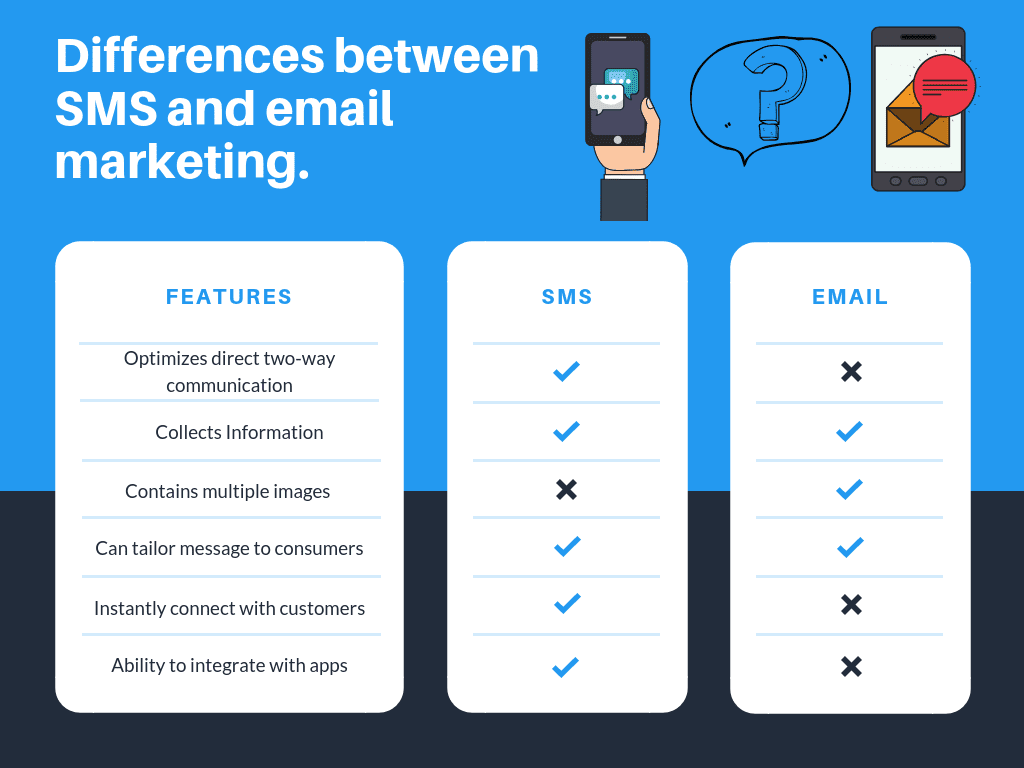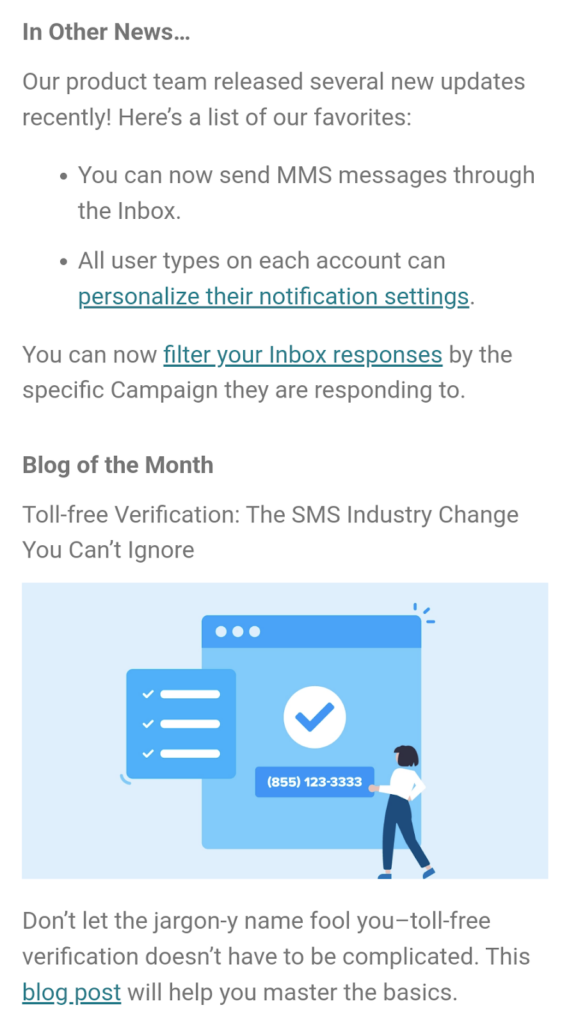Email marketing vs. text message marketing: Which one is right for you?
What's the difference between email and SMS marketing? Figure out which channel is right for your business and how to build an integrated digital marketing plan.

What's the difference between email and SMS marketing? Figure out which channel is right for your business and how to build an integrated digital marketing plan.

You’ve heard the whispers across the Internet.
Email marketing is dead. Long live the text message.
“Wait a minute,” you say. “If email marketing is dead, why is my inbox as full of offers as ever? Why isn’t the whole world texting?”
As much as I love SMS, I’ll be the first to tell you that email marketing is still alive and well and the go-to for many brands.
The thing that a lot of marketing articles won’t tell you is that the “right” marketing method for you and your business is based on what your individual business needs, and that the answer might actually be multiple methods together.
So, how do you choose which two-way communication tool is right for your business (or whether to use both)? We’ll take a deeper look at both email marketing and SMS marketing to help you decide.
TABLE OF CONTENTS
Anytime you launch a new marketing initiative, your first step is to stop and identify the goal you’re trying to reach.
If you’re a nonprofit, are you trying to solicit donations? As a retailer, are you announcing a new clothing line or a Black Friday sale?
Along with the purpose of your marketing strategy, you have several points to consider as you choose between email and text marketing, including:

Whatever you choose, the main idea behind your marketing method is to reach your contact lists quickly, efficiently, and in a way that inspires them to take action.
As a rule of thumb, emails are great when your information isn’t time-sensitive or crucial. Why? Well, the average open rate for an email sits at 33.02%.
Email campaigns are also better suited for business-as-usual updates, like shipping notifications, or times when you have a lot to say.
An email can contain an entire newsletter, a State of the Union-style address for your business, or other detailed information your customers need.
Texts, on the other hand, are generally limited to 160 characters, or 1,600 if you’re using MMS.
I talk a lot about text marketing here (obviously), but why do I recommend it so highly, and what is it good for?
Well, first of all, texts are a sure way to get your message across. SMS open rates remain around 98%, with 51% of consumers reporting that they reply to a text within 1–2 minutes.
This makes SMS a perfect format for short-and-sweet updates you want customers to read right away.
Texts are especially useful for:
Text messaging is also best when you want your contact lists to take fast action, like clicking on links to sign up for programs or take advantage of sales.
Plus, with strict character limits, your campaigns will always be concise and to the point.
That’s a quick rundown on what each method does best, but what about quantity?
The more your audience hears your message, the more likely they are to remember it.
That’s why you might find yourself singing the Stanly Steemer jingle in the shower.
However, if there’s one significant difference between email and SMS marketing campaigns, it’s in the volume and frequency of the messages you send.
As we’ve mentioned, the difference between email and text open rates is major. An estimated 347.3 billion emails are sent daily, as opposed to only around 6 billion text messages.
This means you’ll often have to send email campaigns a few (dozen) times before they get the attention you want.
Text messages work a little differently, mostly because they send directly to your customers’ text inboxes.
This makes SMS a more personal form of communication, given that people only give out their phone numbers to trusted brands, family, and friends.
All that means for your text campaigns is that you can be a little more selective with what you send and how often you send it.
It all depends on your organization. A church might choose to send daily devotionals to its contacts, while a retailer might only send out one text per week to announce discounts or promotions.
This isn’t to say that higher-volume campaigns don’t work with text message marketing. You just have to strike a balance between getting the point across and overwhelming your contacts with messages.
I’m not here to talk down on email marketing. In fact, we here at SimpleTexting believe text marketing couldn’t be what it is today if email hadn’t paved the way.
Still, no marketing method works in every situation. This is why I suggest a healthy mix of both email and text marketing.
Let’s take a look at why SMS and email make a great team.
Your customers are always connected, thanks to their smartphones, but they don’t stare at their email and text inboxes all day.
Combining SMS and email means you’ll reach a larger audience so you’re never limited by one marketing channel.
Sending messages is important, sure, but analyzing the way your messages perform is absolutely crucial.
With a mix of email and SMS, you can get a good idea of some key messaging metrics like:
This will give you a more well-rounded look at how your audience communicates and what they like to see.
Let’s face it: It’s a mobile-first world out there. There are currently around 167.8 million mobile shoppers in the U.S.
While things like billboards and fliers have their own place in marketing, you’ll get the most bang for your buck with marketing channels that work on mobile devices.
This, again, is about reaching your audience where they already are (in this case, on their phones) to be sure they see what you’re sending.
Just make your emails look good in a mobile format, and you’re good to go.

For reference, here’s how SimpleTexting formats its emails for a mobile audience so everything fits on a smaller screen and looks tidy.
Compliance and consent are by far the best way to make sure your customers stay engaged and interested in your communications (they’re also required).
Keeping in compliance with email and texting regulations ensures that your messages get delivered without interruption.
It’s also one of the highlights of these two channels. While compliance may seem like a chore, it prevents spam and helps your audience trust, and therefore interact with, the messages you send.
You’re also much more likely to keep customers around if they’ve consciously agreed to receive your messages.
📖 Recommended reading: The disadvantages of email marketing
Now that you’ve got a better idea of why email and SMS make great teammates, let’s dig into how you might put them to work in your organization.
We all miss messages, it happens. That said, we’re a lot less likely to miss them twice.
If a customer doesn’t open a marketing email announcing the details of your summer sale, you can send a follow-up text days later with more information on specific discounts (or vice versa).
This will go a long way toward making sure your messages never fall through the cracks.
By the way, you don’t have to do this manually. If you use an email marketing service like Constant Contact or Mailchimp, you integrate them with SimpleTexting to trigger texts or emails like these automatically.

Every business owner knows that life sometimes gets in the way of finalizing a sale.
If you’ve got leads ghosting you, reach out through SMS or email to restart the conversation.
You may choose to reach out with the opposite channel of the one they last interacted with you on (as in, sending an email to a customer who left your text on read), or send them a follow-up with both.
It’s all well and good to make individual sales, but really knowing your customers and their buying behavior makes all the difference in your customer retention and bottom line.
I can prove it. 76% of consumers are frustrated with brands that don’t offer personalized experiences.
To give them that kind of personalization, you’ll need details like:
Having two lines of communication open will help you gather all this information and use it to show your customers products they’ll love, tailor which messages you send them, and give them relevant deals and updates.
Send out surveys and requests for feedback to both text and email inboxes to get the most responses possible.
For some extra personalization juice, connect your CRM to your SimpleTexting account to easily store all the details you need.
Businesses are as diverse as the people who run them.
A company that sends a weekly newsletter might want to send it through a drip email, while a different retailer might prefer texting for receipts and order notifications.
The good news is, you don’t actually have to choose. Combine your marketing methods and customize them to meet your needs.
Ready to try text message marketing for yourself? Try out SimpleTexting for 14 days, totally free.
Meghan Tocci is a content strategist at SimpleTexting. When she’s not writing about SaaS, she’s trying to teach her puppy Lou how to code. So far, not so good.
More Posts from Meghan TocciWe split a subscriber list in two and sent each half an identical campaign—only one had a photo and the other didn't. Here's how each campaign performed.
ReadText messages that include discounts can help you grow your subscriber lists, engage your contacts, and influence more sales. Learn how to write discount messages that drive more revenue.
ReadStart a text marketing campaign or have a 1-on-1 conversation today. It's risk free. Sign up for a free 14-day trial today to see SimpleTexting in action.
No credit card required